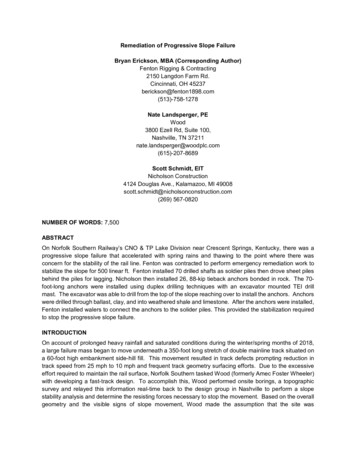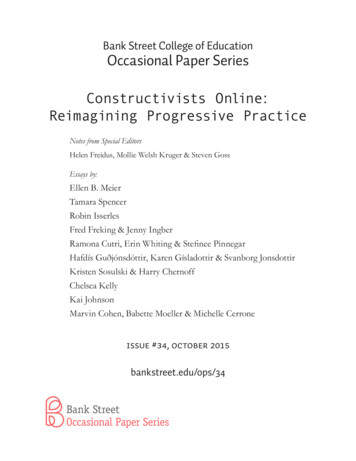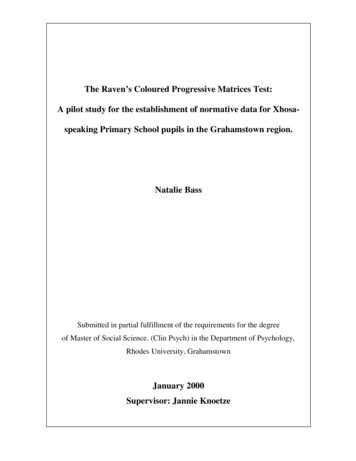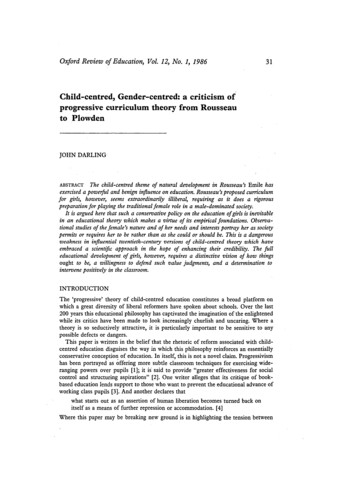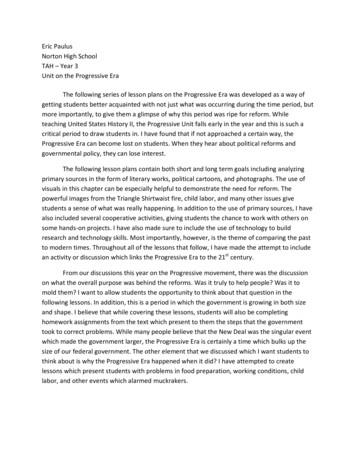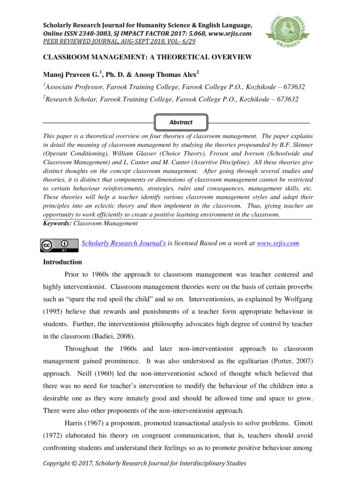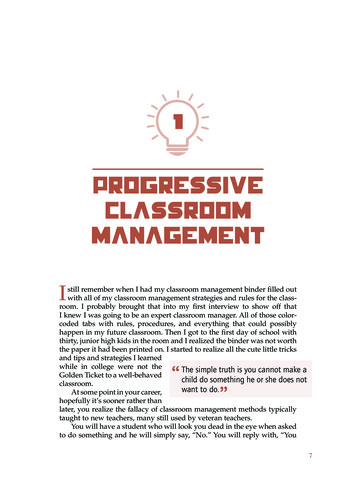
Transcription
1ProgressiveClassroomManagementIstill remember when I had my classroom management binder filled outwith all of my classroom management strategies and rules for the classroom. I probably brought that into my first interview to show off thatI knew I was going to be an expert classroom manager. All of those colorcoded tabs with rules, procedures, and everything that could possiblyhappen in my future classroom. Then I got to the first day of school withthirty, junior high kids in the room and I realized the binder was not worththe paper it had been printed on. I started to realize all the cute little tricksand tips and strategies I learnedwhile in college were not theThe simple truth is you cannot make aGolden Ticket to a well-behavedchild do something he or she does notclassroom.want to do.At some point in your career,hopefully it’s sooner rather thanlater, you realize the fallacy of classroom management methods typicallytaught to new teachers, many still used by veteran teachers.You will have a student who will look you dead in the eye when askedto do something and he will simply say, “No.” You will reply with, “You“”7
8The New Teacher Revolutionbetter or else.” The student will look you back in the eye and answer, “Orelse what?” You will then realize there is no “or else” because you can’tforce him to do anything. Now this might seem like a shock because, as anew teacher, you would hope that you have some power or authority inthe classroom. However, in my experience those teachers who feel theyhave that authority and power are the ones who struggle the most. Themoment you get into a power struggle as the teacher in a classroom, youhave already lost. If we don’t need traditional classroom managementtechniques, then what do we need? How can you as a teacher effectivelymanage a class of students?FOSTER RELATIONSHIPS“The answer to that question is actually quite simple and yet incredibly difficult. One suggestion is to form and foster positive relationships. Again,this sounds simple but many teachers, especially new teachers, strugglewith this. Relationships are key to effective classroom management, buthonestly, I don’t even like using the phrase classroom management. Instead,I like to think of classroom culture as what we should be striving for. Whenthere is a positive culture based on positive relationships, negative behaviors are almost non-existent. To be clear, this goes beyond simply knowingsuperficial information about students to an in-depth understanding oftheir cultural and intellectual background. This knowledge will help fosterdeeper relationships and a great chance of success in the classroom(Jackson, 2009).The culture in a classroom impacts the work you will do as a teacherand can lend itself to relationship building. As a teacher of social science,I spend a great deal of time discussing the cultures of ancient civilizationswith my students. We talk about what makes a culture positive as opposedto negative. A lot of it comes down to values and expectations. What doyou value as a teacher and whatdo you value as a class? As aActions speak louder than words andteacher, I make it crystal clearinfinitely louder than cute posters.through every single thing I saythat I value learning and the voiceof every child and I expect my students to do the same. There are yearswhen it takes classes longer to buy into this philosophy than others.However, it is critically important to be transparent with your studentsabout what you value and how you expect them to treat one another. Youneed to act on these beliefs and not allow them to simply be hollow words.If you talk to any high-quality teacher about how to effectively reach herstudents, she will inevitably say “building relationships.” The funny thingis I don’t recall having any course work on how to build relationships withstudents. The only thing I recall in this area was when I did my high schoolpracticum and we were warned about inappropriate relationships with high”
Chapter 1 Progressive Classroom Managementschool students because we were only a couple years older than they were.Yet building relationships with students is probably the single most important thing we do as teachers. There is nothing more important than gettingto know your student, and I often say you have to know the kid before youcan teach the student. I will also say that there’s a fine line there. I have seenexamples of teachers who cross that line. I’m not referring to teachers whohad inappropriate relationships with students and end up in jail or on thefront page of the newspaper. I am referring to the teacher who wants to formrelationships with kids but doesn’t know where that line is between teacherand students. This often results in students taking advantage of the teacherand the line of respect being quite fuzzy. Simply put, some teachers thinkthey have to be a student’s friend and will stop at nothing to get that student’s friendship. This will lead to a lack of mutual respect and do moredamage to the relationship between student and teacher.Having a relationship with a student and having mutual respect doesnot mean being best friends. It also doesn’t mean being the favorite teacheror being obsessed with students liking you. There are a lot of ways you cango about building a relationship; however, it must be clear that simply having a positive relationship with a student will not make all misbehaviorsdisappear. It has the potential to greatly diminish them, but there are timeswhere you will need to bring in a colleague or an administrator to supportyou in extreme cases of student misbehavior.FOUR EASY WAYS TO FORM POSITIVERELATIONSHIPS WITH STUDENTS1. Say “Hello”The easiest and simplest way is to simply say “Hello.” This may soundridiculous and too simplistic to be effective. However, I will tell you thatsimply greeting every single student every single day will go very far inbuilding a relationship. There are children in our schools who can go anentire school day without a single individual speaking to them. You maythink I am lying or making that up, but that is the sad reality for some ofour students. They are the quiet students and the forgotten ones. They gothrough their entire school day without anybody engaging in a conversation with them because they’re quiet and meek and just do their work anddon’t cause any problems. It can be something as simple as standing at thedoor of your classroom and saying “Good morning” as every kid comes in.2. Have a ConversationGo a step further and ask a student how his evening was or how his favorite sports team did last night. I often find myself in the hallways talkingabout who was kicked off American Idol or how in the world that person9
10The New Teacher Revolutionsurvived on that latest outdoor-survival reality show. Whatever it takes,put yourself in a conversation with every single kid, every single day.Some people will say, “I don’t have time for that.” How can we as teacherssay we don’t have time for our students? Bottom line, we are not in thisbusiness for impressing politicians, upholding a curriculum, or increasingour PISA score, but rather we are in this business for kids.3. Meet Kids Where They AreWe are very fortunate to have a lot of morning and after-school activitiesthe kids can participate in at school. One of my all-time favorites is bombardment. For those of you who aren’t familiar with that game it is thenew way to say dodgeball in a somewhat politically correct manner. Nowwe have dodgeball, I’m sorry, bombardment every winter. My good friendJay has been doing this intramural for as long as I can remember. On anygiven day, we have over 200 students in the gym playing bombardment.On many days, you will see teachers and administrators in there as well.They are not in there because they have to supervise or are required to bethere. They are there because they want to go and play bombardment withthe kids. I always loved playing dodgeball as a child, so I love the opportunity to go in there and throw a ball around and get hit as well. To beclear, the students all voluntarily choose to participate in this intramural,and we no longer use the red rubber balls from our childhood that left ared badge of courage on our cheekbones all morning.Find an extracurricular activity where the kids are and join in. Theywill love seeing you there and enjoy interacting with you in a nonclassroom setting. Most schools have clubs and activities for kids to participatein outside of the school day or possibly during. If not, create one and makeit your own.4. Be RealIn addition to doing the bombardment intramural, Jay also teaches in ourschool’s BD or behavior disorder program. We often talk about howimportant relationship building is and how it is a huge part of what hedoes. He will go so far as to say he could not do his job without creatingthose bonds with kids. Early on in my career he shared why he does all ofthe intramurals and interacts with kids in these extracurricular spaces.First, he thinks teachers who do this have a huge advantage whenthose students come into the classroom setting. No longer are you simplythe teacher who’s pestering them about their schoolwork or yelling atthem about different things they’re not doing. You are now also the guywho is going to the gym and playing games with them as well. You arethe guy that took a shot to the face and split your glasses off of your headbecause the eighth-grade boy (who also pitches on one of the local club’s
Chapter 1 Progressive Classroom Managementbaseball teams) caught you off guard. You have a little bit of street credand to the students you are “real.”Now when you ask that child to do the work or to engage in a conversation about school, you’re not just a teacher. You are now more of a realperson and the more real you are to a kid the more likely they are toengage in whatever you’re asking them to do. While this may sound likejust attempting to be the “cool teacher,” it really is not. Over time, youbuild these relationships to the point where a kid will do anything you askhim to do because he cares about you as a person and knows that you careabout him in the same way. It sounds so simple and it really is. Createsituations where you can engage in real interaction with your students andit will pay off in the classroom when you are asking them to do somethingthey may not be terribly excited to do.ENGAGED LEARNINGAnother rather simple approach or strategy for classroom managementis to take a look at what you’re doing in the classroom. When you thinkabout students who misbehave in a class, there’s always a reason behindit. Good teachers know they need to find out what’s causing the behavior. Yes, there are going to be those rare occasions where students justcannot control themselves. Nothing you do will change their behavioror create an environment where they will be successful. These types ofstudents do exist. However, most students misbehaving in a class aredoing it for a specific reason. There is a trigger or root to the problem.With this in mind, if you want to be successful in managing a classroom,you need to figure out ways to find out why students are acting the waythey are.In order to look at this more closely, I think it’s best to use specificexamples. You will inevitably have a student who will sit in your class anddo nothing. I know this may sound hard to believe but it’s true. Almostevery single year, I have at least one student who goes beyond the realmof rational thought in ways to avoid doing any work. Now if you are likeme, when you’re a new teacher, you will revert back to the way in whichyour own experiences as a student played out. You might assign this student a detention after school togive her some more time to getThe question you should be askingher work done. You mightyourself is, “Why is this student notassign lunch work time for thedoing the work?” The answer to thatstudent to get caught up. Youmight even assign more homequestion will inevitably be differentwork or time in a Saturdayfor every child and be the key to sucschool detention to do the work.cess with that child.What you will find out is none“”11
12The New Teacher Revolutionof those will work. The question you will be asking yourself is “How canI get this student to do the work?”It has been my experience that this question boils down to a few simpleanswers. The first reason most students will not do their work is it is toodifficult for them. I’m not saying that kids will simply whine when thingsget a little difficult, but I mean that there are some things that some students will not be capable of doing. That’s not to say that I have low expectations for my students. The reality is some of your students will struggleto do things in your class. Struggle is OK when there is a chance of success.From the perspective of a student, if something is incredibly hard, it is alot easier to give up on it or not do it then to struggle and look stupid infront of the teacher or peers. The first issue you need to figure out is if thework is too hard for the students.Another possibility is that the work is too easy and perceived as notworth the students’ time. When you ask them, they will simply tell youbecause it’s too easy and they already know it. In some cases, it is true andthe work you’re asking them to do is a complete waste of their time. Inboth of those cases, the work students are being asked to complete must fitwith the students’ abilities. With that in mind, it’s very difficult to askevery student in the class to do the exact same thing, which means you willneed to differentiate the learning activities.Another answer that I have found to the question of a child not doingthe work is not caring about school. Now, this brings on a whole otherlevel, which is difficult to dissect and often stems from a belief system oran attitude that is present in the home environment. If a child has parentswho do not value education, the chances will be higher that the child alsowill not value education. I have been in conferences where parents haveflat out told me they hate a certain subject or school and so their kid willtoo. They even say these things in front of their children. If children heartheir parents say they hate school or they hate math, they now have an outbecause they know their parents will support them. At the end of the day,you have no control over what their parents are telling them or the beliefsystems of a home. Your best bet is to continue doing all you can at schoolto provide a positive learning experience for children in an effort to changetheir own beliefs about school and learning.Three Steps to Increase Levels of Engaged Learning1. Differentiate Instruction and Learning ActivitiesKnowing that no two students will be the same, you will need tolevel your instruction as well as the activities you ask students toengage in. Always have two or three options for students, based ontheir readiness or abilities.
Chapter 1 Progressive Classroom Management2. EntertainSome teachers do not feel we are in the business to entertainstudents but rather are there to teach them. Yes, that is true, butif we can mix the two, it can prove effective. Engage kids in funactivities that will allow them to connect the content to a pleasurable experience. When you are reviewing for a test, have studentscreate games rather than simply a study guide. Bring in multimedia to create a more dynamic method of presenting content. Whileat home, students are bombarded with media and devices (Figure1.1) but are asked to shut them down and power them off whileat school. Try to meet them in the middle and use their tools as away to engage through entertainment.Figure 1.1 Student EngagementSource: Created by Jared Stumpenhorst.3. Promote Failure With PositivityFailure in schools is often met with disapproval and disappointment. However, students need to feel safe to take risks and fail andlearn from those failures. In classrooms built around a positive classroom culture, failure is encouraged as a step in the learning process.Regular conversations can help build this, and a great way is to haveregular class meetings. Former elementary principal Lyn Hilt promotesthe use of classroom meetings as a way for teachers and students toengage in dialogue about values, behaviors, learning, and everythingin between leading to fostering positive learning environments.13
14The New Teacher RevolutionMISBEHAVIOR1.2.3.4.5.Another common behavior issue that comes up in classrooms is the student who just simply misbehaves. He distracts his peers by acting out,yelling, talking, throwing things, or the whole host of other ways in whicha child can distract a class. The list of ways in which a student can distracta class or be off task is infinite. Just when you think you have seen it all,something new will present itself in your classroom. I once had a studentwho enjoyed standing on a table and yelling at his group when they werenot listening to him. It was often in a loud voice and he even told me hewas channeling his inner Adolf Hitler. For me, the misbehaving student isactually easier to “fix” then the students who can’t or won’t do their work.In nearly every single situation of a misbehaving student, it boils down toa few simple reasons.The first reason is a student acts out or misbehaves as a way to seekattention. In my experience, this is the number one reason a student misbehaves in class. Either she doesnot have a good home life whereFive Simple Ways toshe is not getting attention orshe does not know how to seekGive Positive Attentionattention in positive ways. I havehad students tell me there isPut a sticky note with a positivenobody at their home who carescomment on a student’s desk.about them or even talks toCall or e-mail a student’s parent withthem. As sad as that is, it is areality for many students. Theya positive note.go to empty homes or homes fullWalk around the room and interactof people who do not engage orwith students.interact with them. So whenthey are in my classroom, theyGive a simple thumbs-up.will do anything to get attentionfrom other people and especiallyHave a quick conversation after class.from an adult. As a teacher, youneed to find a way to engagewith those students and give them attention in a positive way that doesn’tdistract the rest of your class.Another cause of student misbehavior may in fact be the teaching.Students consistently having behavior concerns may indicate it is time forus as teachers to reflect on our own practices. If your lessons are boringand not engaging, I can almost guarantee you will have misbehaving students in class. If you are asking kids to do something that is too hard or tooeasy or not relevant to them, they will misbehave. Engage kids in meaningful and relevant content and behavior will not be an issue you will bedealing with. One of the best ways to engage them in meaningful andrelevant content will be discussed in the student motivation chapter.
Chapter 1 Progressive Classroom ManagementSome students simply do not know how to behave. Yes, that seemssilly but the truth of the matter is not all students have great familydynamics where they are taught manners and politeness and what itmeans to interact positively with peers or adults. Some of your studentswill go home and swear at their parents or possibly be involved in physicalaltercations with them and that is completely acceptable behavior. Theyhave no consequences at home for such behaviors. Students who comefrom those home environments often clash with the school environment.They are doing things that are tolerated, and in some cases, encouraged intheir own home. These students often have so much learned behavior fromhome that it is very difficult to help them be successful in school becausetheir behavior gets in the way of their learning. It is far easier to disciplinechildren with detentions and suspensions t
7 1 Progressive Classroom Management I still remember when I had my classroom management binder filled out with all of my
